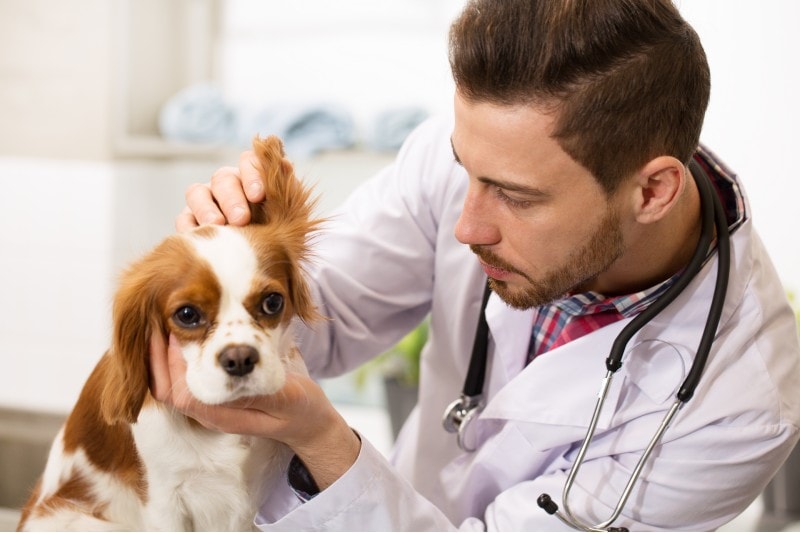Can You Use Coconut Oil for a Yeast Infection in Dog Ears? Vet Approved Advice
By Adam Mann
Updated on

Click to Skip Ahead
If your dog has a yeast infection in their ears, the internet is full of potential home remedies. One of the more popular options on the internet is putting coconut oil on or in their ears. But what does this home remedy have in common with other home remedy options? They don’t work and can do more harm than good!
Skip the coconut oil and instead take your pup to the vet to get them the diagnosis and treatment they need. But what causes yeast infections in dogs, and what are some common signs you should observe before taking them to the vet? We’ve answered both those questions and more for you below.
How Should You Treat a Yeast Infection in Dogs?
While there’s a lot of information out there about potential home remedies for yeast infections in dogs, the truth is that there’s little science to back up the effectiveness of these treatments.
Coconut oil is generally considered to be safe as a skin moisturizer, but it can cause irritation for some dogs. You should always take your dog to the vet for diagnosis and treatment of ear problems, instead of experimenting with your dog’s health and trying to come up with a home remedy.
Medicated ear drops containing an antifungal (to kill the yeasts) and anti-inflammatories (to help with the swelling and discomfort) are commonly prescribed. Ears cleaners may also be advised to keep the ear canal clean, follow your vet’s instructions on which product to use and how often the ears need cleaning. If your pup is in a lot of pain, your vet may also prescribe oral anti-inflammatory pain relief to keep them comfortable while the infection is treated. As most yeast ear infections are caused by an underlying condition, the underlying cause will need investigating and treating to help prevent the infection from recurring.

What Causes Yeast Infections?
Yeast are fungi which in low numbers are part of the normal flora of your dog’s skin. When these yeasts overgrow and are present in excessive amounts, it causes an infection. Malassezia are the most common species of yeast to affect a dog’s skin and ears.
Yeast ear infections generally occur due to another issue which weakens the normal skin defenses and allows them to overgrow. The most common underlying causes are skin allergies, but hormonal issues like hypothyroidism (an underactive thyroid) or anything that suppresses the immune system, can also lead to yeast infections. In addition, particularly for dogs that like to swim a lot, moisture in the ear canal can also make them more prone to ear infections.
Signs of Yeast Infections
If you think your dog has a yeast infection, there are a few signs you can look for before you schedule an appointment. If your dog has any of the following signs, we recommend taking them to the vet for a proper diagnosis and treatment options.
- Red or brown ear discharge
- Red or irritated ear
- Itching or scratching at the ear
- Musty smell coming from the ear
The signs of a yeast infection are very similar to a bacterial infection and other ear problems. Your vet will need to examine the ear canal with an otoscope, and they may take a sample of the discharge to examine under the microscope to diagnose the problem.

Tips for Preventing Yeast Infections
Once the yeast infection has been treated and resolved, the key to preventing them recurring is to keep the ear canal healthy, and as dry as possible.
Keep Their Ears Dry
Moist or wet ear canals can predispose dogs to developing ear infections so one way to help prevent recurrence is to keep the ear dry. Keep water out of the ears as much as possible and dry the ears anytime they get wet. Your vet may recommend a special ear cleaner to use.

Treat Underlying Conditions
Underlying conditions must be diagnosed and addressed to prevent yeast and other infections from recurring and keep skin healthy. Dogs diagnosed with food allergies will need a special diet and allergy medication is available for environmental allergies. Hormonal conditions will need to be treated with appropriate prescription medications.
While you might think you can treat things with home remedies, you don’t have the medical expertise or access to the necessary medications to make things better for your dog.
Final Thoughts
Now that you know a little more about what you should and shouldn’t do if you think your pup has a yeast infection in their ear, all that’s left for you to do is call the vet and see when you can get them in. Ear infections are uncomfortable for your pet, and the only way to get them to get better is to get them on the right medication and investigate the underlying cause.
Featured Image Credit: etorres, Shutterstock













